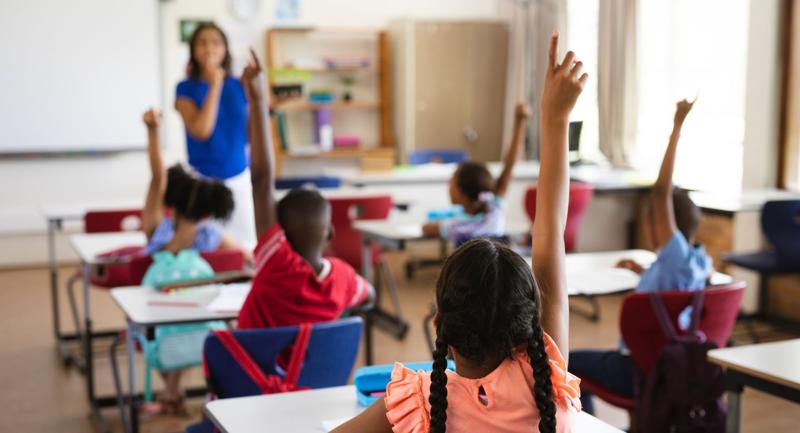Research Alert
A Look at Tiered Interventions in High School
Are you wondering how you might implement Response to Intervention (RTI) in high school? The far greater complexity that characterizes a school day in the upper grades rules out simply scaling up what worked for elementary schools.
A new report can help: Tiered Interventions in High Schools: Using Preliminary "Lessons Learned" to Guide Ongoing Discussion. The report includes data from eight high schools across the United States that have successfully implemented RTI.
Of special interest are the school profiles (Appendix B), which illustrate how RTI looks in different settings. There are similarities across schools—for example, most of the schools observed have three tiers of instruction that focus on reading and math, most target 9th and 10th graders, and several provide behavioral supports as well as interventions for English language learners.
The differences, however, are noteworthy. Some schools have implemented RTI to curb the trend of many students failing multiple classes, whereas some focus more specifically on struggling 9th graders. Tiered instruction also looks different across schools because each school has customized it to its needs. For example, one high school has created Tier 2 supports in 9th and 10th grade English classes that a teacher and intervention specialist coteach; another school offers Tier 2 instruction during a guided study hall; a third involves students in designing Tier 2 interventions.
The report, which was prepared by the National High School Center, the National Center on Response to Intervention, and the Center on Instruction, is available online at www.betterhighschools.org/pubs/documents/HSTII_LessonsLearned.pdf.
PageTurner
"Educators today are like tightrope walkers without a safety net, responsible for meeting the needs of every student, with little room for error."—Austin Buffum, Mike Mattos, and Chris Weber, p. 10
Numbers of Note
World Spin
The Benefit of Getting Things Wrong
In Paris, a group of academics recently held an unusual event—a festival of errors that celebrates making mistakes. Détrompez-Vous! (Make No Mistake!) dared 6- to 12-year-olds to think outside the box in science, to not worry about coming up with the "right" answer.
The program, which has taken place every year since 2006, attempts to counter what organizers call a culture of "intellectual timorousness" in France by encouraging students to take risks with their thinking—that is, to risk making mistakes. Errors are especially looked down on in the French education system, which emphasizes factual learning over creative problem solving.
Workshops this year enabled students to explore a variety of issues, such as how to critique scientific arguments in advertisements and how to analyze and learn from—rather than ignore—the errors one makes in science.
Workshops promoted dialogue and hands-on learning. In one workshop, students were given a recipe that had a list of ingredients but no directions. The students produced their dishes with varying degrees of success, analyzing what went wrong with the finished product. In another workshop, students learned how optical illusions can lead to errors of interpretation and what these "errors" can teach us about the way we see.
Détrompez-Vous! aims at fostering enthusiasm for science in at-risk students in impoverished regions around Paris. For more information (in French), visit the festival's website at www.paris-montagne.org/festival2249/edition-2010/ateliers.
Only Online
Resources for English Learners
English language learners (ELLs) bring such a mix of struggles, experiences, and hidden talents to class that their teachers need a strong mix of strategies. Colorín Colorado!, a bilingual website about ELLS and reading (geared toward Spanish speakers), provides dozens of downloadable resources for teachers, parents, and librarians.
Bilingual tip sheets, leveled book lists, reproducible parent handouts on supporting your child's reading, a 92-page tool kit for reaching out to Latino parents (including illiterate parents), video clips of Latino children's authors, free newsletters—it's all here and free. Join a social network of fellow ELL educators (through Ning), and sign up for RSS feeds of articles on specific topics.
Relevant Reads
- Response to Intervention (RTI) and English Learners: Making It Happen by Jana L. Echevarria and MaryEllen J. Vogt (Allyn and Bacon, 2010)The key to helping English learners succeed is the same as the key to helping all learners succeed—identifying and responding to their individual needs. Response to Intervention, with its emphasis on targeted instruction, offers a powerful framework for teaching English learners. Echevarria and Vogt, two of the developers of the widely used Sheltered Instruction Observation Protocol (SIOP) model for teaching English learners, provide practical ideas for implementing this model within RTI." In our efforts to assist students in reaching benchmarks, attaining standards, and passing standardized tests, we may lose sight of the whole child (p. 24)."
- The Promise of Preschool: From Head Start to Universal Pre-Kindergarten by Elizabeth Rose (Oxford University Press, 2010) Although U.S. political leaders today seem to view early childhood education as a worthwhile investment, major questions remain. Should early childhood programs be attached to the K–12 school system, and thus emphasize academic growth; or should they focus on children's physical, social, and emotional development? Should preschool be universal or targeted to low-income children who might benefit most? Rose looks at how preschool education and related research have evolved over the last four decades and how this history frames current debates. "To fulfill preschool's promise, we need not only to make sure it is of the highest quality but also to make it part of reforming both early elementary education and child care (p. 227)."








